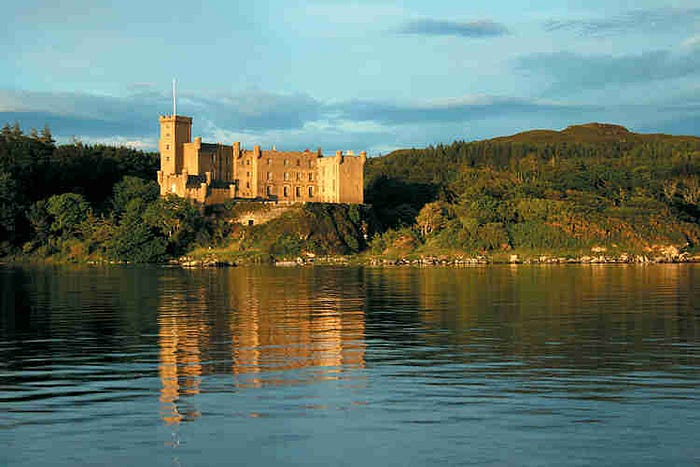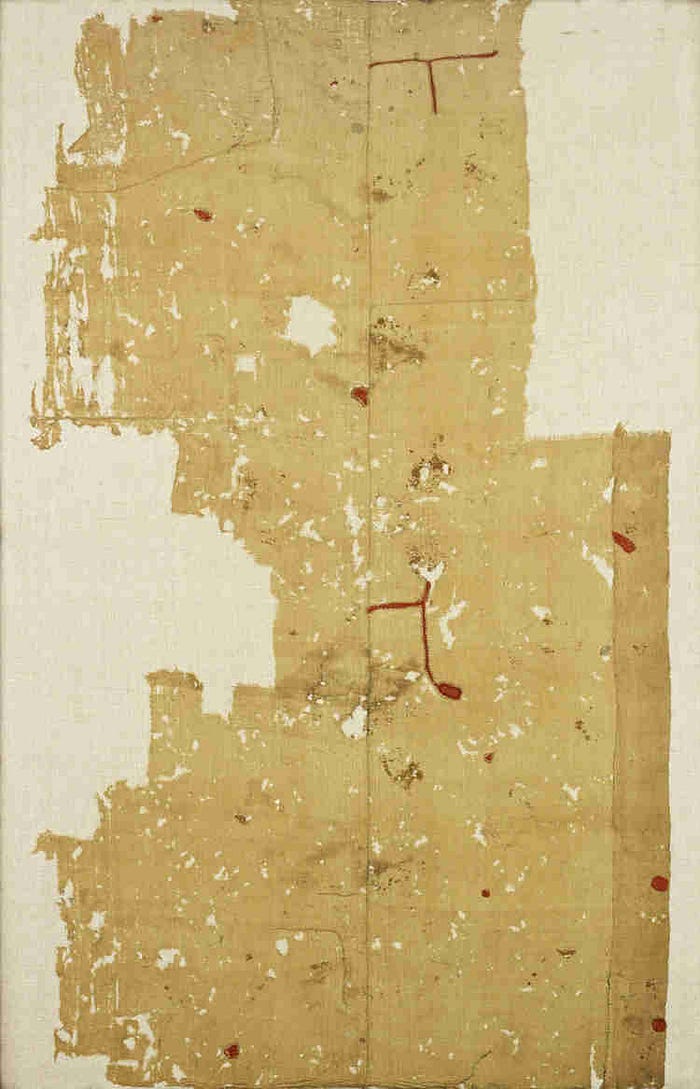Scottish Folklore: The Fairy Flag of Dunvegan Castle

Introduction
In Dunvegan Castle, Isle of Skye resides a small scrap of fabric that holds immense history and is the subject of many stories relating to clan MacLeod and the world of Faery. This Fairy Flag is one of the few objects still existing to this day said to have been created by the fairies.

What is the Fairy Flag?
In the simplest sense, the Fairy Flag (Am Bratach Sith in Scots Gaelic) is a scrap of very frayed yellow silk with some red spotting.

There apparently used to be red crosses also on the fabric, however, these faded out over a century ago. Experts who have examined the flag believe it to be silk from Syria or Rhodes dating between the 4th and 7th centuries AD. It is hypothesised it could even be a potential saintly relic.
In terms of lore and infamy, the Fairy Flag is considered a gift from the land of Faery to Clan MacLeod in order to protect them from all harm. It is said to have cured family members of illness, cured cattle of a plague, brought herring to the Loch and boosted the fertility of both humans and livestock.
Origin of the Flag
So how did this amazing flag end up in the possession of clan MacLeod? Well, that is where we start to get many variations on the story, with it coming from a fairy themselves, having been given to a crusader by a fairy in the Holy Land or actually having been another very famous flag tied to a Viking who is an ancestor of the MacLeods.
The Fairy Wife
One of the more common stories told is that a chieftain of clan MacLeod took a fairy for a wife. At some point, she was compelled to return to her homeland and took her son with her to the Fairy Bridge, believed to tie to the land of Faery, before leaving him wrapped in the silk flag and departing.
This Fairy Bridge is a real place by the way and is not too far from Dunvegan Castle.
It is in this story that she had informed the clan that the flag would bring victory when the clan was struggling in battle but could only be used three times before it would disappear forever.
The Sympathetic Fairy
In another variation, the heir of Clan MacLeod, as a baby or toddler, was crying in his crib when a fairy overheard him. In some stories, this is the mother and fairy wife. Sympathetic to the child, she wrapped him in the flag and began singing him a lullaby. This lullaby was overheard by the nurse, now known as the Dunvegan Lullaby, and so this was sung from then on to all heirs of Clan MacLeod.
The Crusading MacLeod
Yet another version of the story sees a MacLeod ancestor who took part in the crusades meeting with a fairy while in the Holy Land. This fairy then proceeded to present the flag to this crusading knight who brought it home with him.
It is highly likely this version of the story evolved from the discovery of the flag’s material coming from Syria or Rhodes, however, it does tie into the final and most probable origin story that is known for the flag.
Harald Hardrada
Part of the reason the flag is so badly damaged is the fact it was for years used in the bedclothes of future heirs for centuries in order to protect them and ensure the longevity of the MacLeod line. But even in more recent times, the flag has been used to protect against harm.s under this flag that Hardrada was killed in 1066 during the Battle of Stamford Bridge in 1066 by England’s new king Harold Godwinson[1].
He did have a connection to the Middle East as he was part of the Varangian Guard for the Byzantine Emperor in Constantinople, perhaps he received the material for services provided or perhaps he did meet a fairy woman out there who gave it to him as a gift.
Lore and History of the Flag
Part of the reason the flag is so badly damaged is the fact it was for years used in the bedclothes of future heirs for centuries in order to protect them and ensure the longevity of the MacLeod line. But even in more recent times, the flag has been used to protect against harm.
During World War Two, servicemen (mainly pilots) of Clan MacLeod carried a picture of the flag into battle with them as a talisman against harm. Dame Flora MacLeod even offered to wave the flag in order to fend off a potential German invasion.
In 1939 the South Wing of Dunvegan castle caught fire, severely damaging the structure. The flag was carried to safety and as it was it is said that the wind dropped, the flames abated, and the castle was saved from total ruin.
Potential Uses of the Flag
The clan claims the flag has only been used twice, and that there is a blanket ban on using it a third time[2]. However, there are a few times that it has been referenced in history including the 1490 and 1520 battles with the MacDonalds. The most interesting and seemingly widely believed use of the flag is after the Trumpan Church Fire of 1578 also known as the Battle of the Spoiled Dyke.

The MacDonalds came to get revenge upon the MacLeods[3], and so barred the only door to the church where the congregation was currently worshipping. They then set the church ablaze killing all inside, apart from one young girl who managed to escape. Although this girl did succumb to her wounds, she was able to raise the alarm at Dunvegan Castle and the fairy flag was unfurled. The MacDonalds were then slaughtered before being buried in a mass grave.
References
Books
Legends and Folklore: Scotland, R.S. Holland
A Dictionary of Scottish Phrase and Fable, Ian Crofton
In Dunvegan Castle, Isle of Skye resides a small scrap of fabric that holds immense history and is the subject of many stories relating to clan MacLeod and the world of Faery. This Fairy Flag is one of the few objects still existing to this day that is said to have been created by the fairies.
Websites
https://www.dunvegancastle.com
https://www.historic-uk.com/HistoryUK/HistoryofScotland/The-Fairy-Flag-of-the-MacLeods/
https://www.theskyeguide.com/walking-mainmenu-32/13-moderate-walks/25-macleods-maidens
http://cscs.academicblogs.co.uk/the-massacre-of-eigg-in-1577/
Footnotes
[1] Harold would die only weeks later during the Battle of Hastings
[2] Probably tying into the Prophecy of the MacLeod’s Maidens which predicts the doom of clan MacLeod with one of the factors being that the Fairy Flag can no longer be displayed.
[3] It is considered that this was likely revenge for the Massacre of Eigg, 1577 where 395 men, women, and children who were hiding in the Cave of Francis were asphyxiated after Clan MacLeod covered the entrance with heather and other items before setting it ablaze. Bones have been found over the centuries in this cave with 50 bones being found as recently as 2017.
